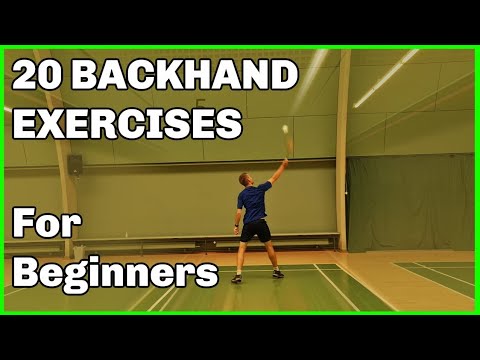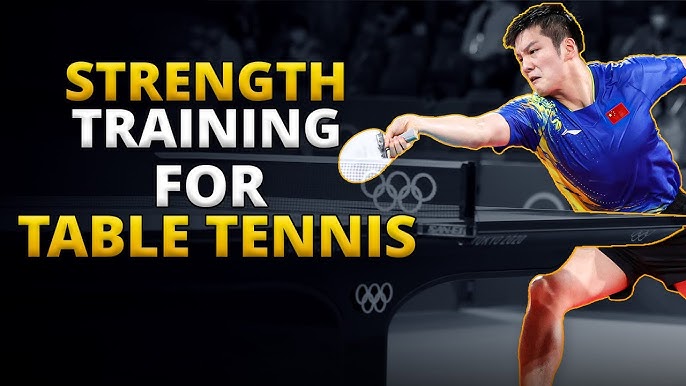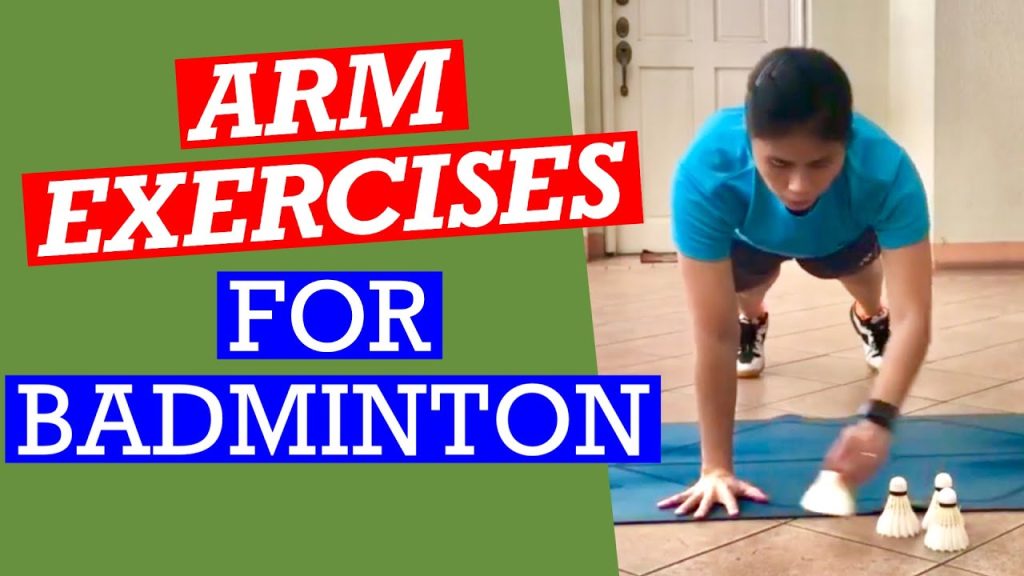Badminton backhand strength is crucial for a strong game. It helps in powerful shots and faster returns.
In this blog, we explore essential training techniques to boost your backhand strength. Badminton players often struggle with backhand shots. Weak backhands can limit your game. Enhancing your backhand strength not only improves your shot power but also your overall performance.
This blog will guide you through effective exercises and tips. These methods will help you build the necessary muscle strength. They are easy to follow and fit into your daily routine. Strengthening your backhand can elevate your badminton skills. Get ready to improve your game with targeted training. Let’s dive into the best ways to enhance your backhand strength.
Importance Of Backhand In Badminton
The backhand stroke in badminton is crucial. It affects your performance and strategy. Many players neglect backhand training. This neglect leads to weaknesses in their game. Improving your backhand can enhance your skills. You will gain confidence and versatility.
Impact On Overall Game
A strong backhand impacts your entire game. It provides balance between forehand and backhand shots. This balance keeps your opponent guessing. You can control rallies better with a solid backhand. It opens up more shot options. Playing at the net becomes easier. Defensive plays improve too.
Common Mistakes
Many players struggle with backhand strokes. They often use incorrect grip techniques. This reduces power and accuracy. Some players don’t use their non-dominant hand effectively. This limits their reach. Poor footwork also affects backhand shots. They fail to position themselves properly. These mistakes hinder their performance.

Credit: www.youtube.com
Understanding Backhand Mechanics
Mastering the backhand in badminton requires a good grasp of its mechanics. It’s not just about hitting the shuttlecock. Proper technique ensures power and accuracy. Training your backhand involves understanding the grip, stance, and swing. This section breaks down each part to help you improve your game.
Grip And Stance
The grip is crucial for a strong backhand. Hold the racket loosely. Use a backhand grip with the thumb pressing against the wider part of the handle. This grip offers better control and power. Your stance should be relaxed yet balanced. Stand with feet shoulder-width apart. Keep your knees slightly bent. This position allows for quick movement and stability.
Swing Technique
The swing begins with a short backswing. Bring the racket back, keeping your elbow close to your body. Rotate your torso to add power. As you swing forward, extend your arm fully. Snap your wrist at the point of contact. This snap generates the needed speed and power. Follow through by letting the racket continue its natural motion. This ensures a smooth and effective shot.
Strength Training Basics
Strength training is essential for improving your badminton backhand. A strong backhand gives you better control and more power. Let’s dive into the basics of strength training for badminton backhand.
Key Muscle Groups
Several muscle groups play a role in your backhand strength. The forearm muscles are crucial for gripping the racket. Strong shoulders help with powerful swings. Your core muscles stabilize your body during the shot. Lastly, leg muscles provide the base and balance needed for quick movements.
Types Of Exercises
Strength training exercises vary, but some are especially effective for badminton backhand. Wrist curls improve forearm strength. Shoulder presses and lateral raises build strong shoulders. Planks and Russian twists strengthen your core. Squats and lunges enhance leg strength and stability.
Incorporate these exercises into your training routine. Consistent practice will boost your backhand power and control. Strength training is a game-changer for your badminton skills.
Resistance Training For Backhand
Resistance training is essential for improving your backhand in badminton. Strengthening your muscles can enhance your power and control. This training can help you play longer without getting tired. Let’s look at some effective resistance training methods for your backhand.
Using Dumbbells
Dumbbells are great for building muscle strength. Start with light weights. Hold a dumbbell in each hand. Perform wrist curls to strengthen your forearm muscles. This helps in controlling your racket better.
Next, try reverse wrist curls. These target different muscles in your forearm. Do three sets of 15 reps. Gradually increase the weight as you get stronger. This will improve your backhand shots.
Resistance Bands
Resistance bands are another excellent tool. They are portable and versatile. Attach a resistance band to a sturdy object. Hold the other end with your racket hand. Pull the band towards your body. This mimics the backhand motion.
Do this exercise slowly. Focus on the movement. Repeat 15 times for three sets. This will enhance your muscle memory. It will also boost your backhand power and accuracy.
Both dumbbells and resistance bands can greatly improve your backhand. Consistent training will lead to better performance on the court.
Plyometric Exercises
Plyometric exercises are a great way to build backhand strength in badminton. These exercises focus on explosive movements. They help improve power and speed. They also enhance agility and coordination, essential for badminton players.
Explosive Movements
Explosive movements are key in plyometric training. These include jumps, hops, and bounds. They mimic the quick, powerful actions needed in badminton. Practicing these moves increases muscle strength and reaction time. For example, jump squats and box jumps are effective. They work the leg muscles and improve overall agility.
Benefits For Power
Plyometric exercises offer many benefits for power. They help generate more force in each stroke. This leads to stronger backhand shots. Increased power also means better control over the shuttle. Players can react faster and with more precision. This makes them more competitive on the court.

Credit: www.tiktok.com
Flexibility And Mobility
Flexibility and mobility are key components of badminton backhand strength training. They help improve your range of motion and reduce the risk of injury. Incorporating regular flexibility and mobility exercises can enhance your performance.
Stretching Routines
Stretching routines should be a part of your daily training. Focus on stretching your shoulders, wrists, and back. Hold each stretch for at least 30 seconds. This will lengthen your muscles and improve flexibility. Remember to breathe deeply during each stretch. It helps in relaxing your muscles and increasing the stretch.
Dynamic Warm-ups
Dynamic warm-ups are essential before starting your backhand training. They prepare your body for physical activity. Start with arm circles to loosen your shoulders. Follow with wrist rotations to mobilize your wrists. Include side lunges to stretch your legs and back. These movements increase blood flow and activate your muscles. Perform each exercise for about 10-15 repetitions. This ensures your body is ready for the intense training ahead.
Incorporating Core Strength
Badminton requires agility, speed, and precision. A strong core enhances all these aspects. Core strength improves your backhand shots, giving you more power and control. Let’s explore some essential exercises and tips.
Core Exercises
Core exercises are crucial for improving your badminton backhand. They build muscle strength and endurance. Here are some effective exercises:
- Planks: Hold a plank position for 30 seconds to 1 minute. Keep your body straight.
- Russian Twists: Sit on the floor, lean back slightly, and twist your torso. Use a medicine ball for added resistance.
- Leg Raises: Lie on your back and lift your legs. Keep them straight and lower them slowly.
- Bicycle Crunches: Lie on your back, lift your knees, and alternate touching each knee with the opposite elbow.
- Mountain Climbers: Start in a plank position and alternate bringing your knees to your chest quickly.
Stability And Balance
Stability and balance are key for effective backhand shots. They help you stay in control and react quickly. Here are some tips to improve your stability and balance:
- Single-Leg Stands: Stand on one leg for 30 seconds. Switch legs. This improves balance and stability.
- Balance Board: Use a balance board to challenge your core muscles. It enhances your stability.
- Yoga: Practice yoga poses like the Tree Pose. It helps with balance and focus.
- Pilates: Incorporate Pilates exercises that target your core. They improve overall stability.
- Agility Drills: Perform drills that require quick changes in direction. They enhance balance and coordination.
Incorporating these exercises and tips into your training routine will strengthen your core. A strong core will improve your badminton backhand strength, giving you the edge you need on the court.

Credit: www.aliexpress.com
Creating A Training Schedule
Creating a training schedule for badminton backhand strength training is essential. It ensures consistent progress and helps avoid injuries. A well-structured plan boosts performance and builds muscle strength. This section covers key aspects of crafting a training schedule.
Frequency And Duration
Start with two to three sessions per week. Each session should last about 30-45 minutes. This frequency allows your muscles to adapt and grow stronger. Over time, you can increase the duration to 60 minutes. But always listen to your body. Don’t push too hard too soon.
Balancing Rest And Activity
Rest is crucial for muscle recovery. After a training session, give your muscles 48 hours to recover. This prevents overuse injuries and ensures better performance. Include light activities like walking or stretching on rest days. This keeps your body active without straining it.
Tracking Progress
Tracking progress is a crucial part of badminton backhand strength training. It helps you understand what works and what doesn’t. By setting goals and monitoring improvements, you can make steady progress. This section will guide you on how to track your progress effectively.
Setting Goals
Start by setting clear and achievable goals. These goals should be specific and time-bound. For example, “Increase backhand power by 20% in 3 months.” This gives you a clear target to work towards.
Write down your goals and revisit them regularly. Keep them visible to stay motivated. Break them down into smaller milestones. This makes it easier to track and celebrate small wins along the way.
Monitoring Improvements
Keep a training journal. Note down your workouts, exercises, and repetitions. Record how you feel after each session. This helps you see patterns and identify what works best for you.
Use videos to track your technique. Record your backhand strokes and compare them over time. Look for improvements in form and power. This visual feedback is invaluable for fine-tuning your technique.
Measure your strength gains. Use a consistent method to track your progress. For example, use the same resistance bands or weights. This ensures your measurements are accurate and comparable over time.
Consider using a table to log your progress:
| Date | Exercise | Reps | Weight | Notes |
|---|---|---|---|---|
| Jan 1 | Backhand Drill | 10 | 5kg | Felt strong |
| Feb 1 | Backhand Drill | 12 | 5kg | Improved form |
Reflect on your progress monthly. Adjust your goals and training routine as needed. Stay committed and patient. Progress takes time, but with consistent effort, you’ll achieve your goals.
Injury Prevention
Injury prevention is crucial in badminton backhand strength training. Proper training helps avoid unnecessary strain and injuries. Strengthening your backhand safely ensures long-term performance and enjoyment of the sport. Let’s explore key aspects to keep in mind.
Proper Technique
Using the right technique is vital. Correct form prevents overuse injuries. Always keep your wrist firm, not too stiff. Avoid bending your elbow too much. A relaxed grip is essential. This helps in maintaining control and reducing stress on your muscles.
Safe Training Practices
Safe training is non-negotiable. Warm-up before starting your backhand drills. Dynamic stretches prepare your muscles. Start with light exercises. Gradually increase intensity. Cool down after sessions. Stretching post-training helps in muscle recovery. Listen to your body. Rest if you feel pain. Overtraining can lead to serious injuries. Rest days are important. They give your muscles time to heal.
Frequently Asked Questions
How Can I Improve My Backhand Strength?
Improving your backhand strength in badminton involves regular strength training, focusing on wrist and forearm exercises. Incorporate resistance bands, dumbbell curls, and wrist rotations into your routine. Consistency is key to seeing results.
What Exercises Help With Backhand Power?
Exercises like wrist curls, forearm planks, and resistance band training are great for boosting backhand power. These exercises enhance muscle endurance and strength, crucial for powerful backhand shots.
How Often Should I Train My Backhand?
Train your backhand strength 2-3 times a week for optimal results. Ensure you give your muscles time to recover between sessions to avoid injury.
Can Resistance Bands Improve Backhand Strength?
Yes, resistance bands are excellent for improving backhand strength. They provide variable resistance, which helps in building muscle endurance and power, crucial for a strong backhand.
Conclusion
Building strong backhand skills in badminton takes dedication. Focus on regular practice. Strengthen your arm and wrist muscles. Incorporate diverse exercises to avoid boredom. Stay consistent and patient. Progress comes with time and effort. Keep challenging yourself. Proper training will improve your backhand performance.
Enjoy your journey to better badminton skills.



